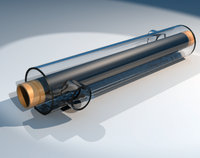
Photo from wikipedia
Abstract This communication aims to report heat transfer characteristics from a non-isothermal wavy disk rotating in a forced flow. The primary objective of this kind of studies is to seek… Click to show full abstract
Abstract This communication aims to report heat transfer characteristics from a non-isothermal wavy disk rotating in a forced flow. The primary objective of this kind of studies is to seek a suitable mechanism for the quick removal of heat energy from a rotating disk surface. The achievement of an efficient mechanism which ensures a further higher rate of heat transfer is a fundamental goal in such studies. In this regard active and passive techniques are of fundamental importance whereby the current study utilizes a combination of both. There are three key elements, namely, the non-uniform disk temperature; surface roughness, and a radial free flow, which are responsible for the augmentation of the heat transfer. The analysis has been carried out for a variety of fluids depicting the increased rate of heat transfer due to a variation of these different elements. In doing so, the local and global heat transfer rates are manipulated in order to obtain a clear picture of the heat transfer process at a corrugated disk. The considered rough non-isothermal disk (with two sinusoids) rotating in the uniform stream of air (Pr = 0.71) leads to a significant (about 263%) enhancement in the overall heat transfer rate compared to that of a flat free rotating disk having surface temperature as quatratic function of the radial coordinate. Moreover, some threshold values (which correspond to seizing the heat transfer process) of the used power-index of the disk temperature (Tw − T∞ = c0rn∗) are also identified which are observed to vary slightly due to the surface irregularities and the relative motion of fluid and disk.
Journal Title: International Communications in Heat and Mass Transfer
Year Published: 2020
Link to full text (if available)
Share on Social Media: Sign Up to like & get
recommendations!